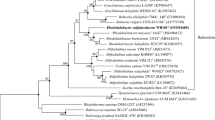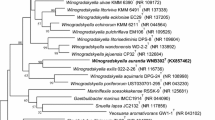Abstract
A Gram-stain-negative, non-motile, aerobic, rod-shaped and reddish-pigmented bacterium, designated 8A47T, was isolated from a marine solar saltern located in Wendeng, PR China. The novel strain 8A47T grows at 20–42 °C, pH 7.0–9.0, and in the presence of 2.0–14.0% (w/v) NaCl. Optimal growth was observed at 37–40 °C, pH 7.5–8.0, and with 4.0–6.0% (w/v) NaCl. The phylogenetic analysis based on 16S rRNA gene sequences revealed that strain 8A47T formed an evolutionary lineage with members of the genus Rhodohalobacter. Strain 8A47T exhibited high level of similarity to Rhodohalobacter barlenses MCCC 1K03442T (94.7%) and Rhodohalobacter halophilus JZ3C29T (93.5%). The major fatty acids were summed feature 3 (C16:1 ω7c and/or C16:1 ω6c), C16:0 and iso-C15:0. The sole respiratory quinone was MK-7. The polar lipids of the new isolate consisted of diphosphatidylglycerol, phosphatidylglycerol, phosphatidylethanolamine, one unidentified lipid, two unidentified phospholipids and three unidentified glycolipids and. The genomic DNA G + C content of the strain 8A47T was 47.7 mol%. Based on its phenotypic, chemotaxonomic, genotypic and genomic characteristics presented in this study, strain 8A47T is considered to represent a novel species of the genus Rhodohalobacter, for which the name Rhodohalobacter mucosus sp. nov. is proposed. The type strain is 8A47T (= KCTC 62603T = MCCC 1H00329T).

Similar content being viewed by others
References
Bowman JP (2000) Description of Cellulophaga algicola sp. nov., isolated from the surfaces of Antarctic algae, and reclassification of Cytophaga uliginosa (ZoBell and Upham 1944) Reichenbach 1989 as Cellulophaga uliginosa comb. nov. Int J Syst Evol Microbiol 50:1861–1868
CLSI (2012) Performance standards for antimicrobial susceptibility testing, twenty-second informational supplement CLSI document M100–S22. Clinical and Laboratory Standards Institute, Wayne
Cowan ST, Steel KJ (1974) Bacterial characters and characterization, 2nd edn. Cambridge University Press, Cambridge
Felsenstein J (1981) Evolutionary trees from DNA sequences: a maximum likelihood approach. J Mol Evol 17:368–376
Fitch W (1971) Towards de ning course of evolution: minimum change for a specified tree topology. Syst Zool 20:406–416
Goris J, Konstantinidis KT, Klappenbach JA, Coenye T, Vandamme P, Tiedje JM (2007) DNA-DNA hybridization values and their relationship to whole-genome sequence similarities. Int J Syst Evol Microbiol 57:81–91
Han SB, Yu YH, Ju Z, Li Y, Zhang R, Hou XJ, Ma XY, Yu XY, Sun C, Wu M (2018) Rhodohalobacter barkolensis sp. nov., isolated from a saline lake and emended description of the genus Rhodohalobacter. Int J Syst Evol Microbiol 68:1949–1954
Kates M, Work TS (1972) Techniques of lipidology: isolation, analysis, and identification of lipids. Lab Tech Biochem Mol Biol 3:0151–0155
Kim OS, Cho Y-J, Lee K, Yoon SH, Kim M, Na H, Park SC, Jeon YS, Lee JH, Yi H, Won S, Chun J (2012) Introducing EzTaxon-e: a prokaryotic 16S rRNA gene sequence database with phylotypes that represent uncultured species. Int J Syst Evol Microbiol 62:716–721
Kimura M (1981) A simple method for estimating evolutionary rates of base substitutions through comparative studies of nucleotide sequences. J Mol Evol 16:111–120
Kroppenstedt RM (1982) Separation of bacterial menaquinones by HPLC using reverse phase (RP18) and a silver loaded ion exchanger as stationary phases. J Liq Chromatogr 5:2359–2367
Kumar S, Stecher G, Tamura K (2016) MEGA7: molecular evolutionary genetics analysis version 7.0 for bigger datasets. Mol Biol Evol 33:1870–1874
Lee I, Kim YO, Park SC (2015) OrthoANI: an improved algorithm and software for calculating average nucleotide identity. Int J Syst Evol Microbiol 66:1100–1103
Liu QQ, Li XL, Rooney AP, Du ZJ, Chen GJ (2014) Tangfeifania diversioriginum gen. nov., sp. nov., a representative of the family Draconibacteriaceae. Int J Syst Evol Microbiol 64:3473–3477
Meier-Kolthoff JP, Auch AF, Klenk HP, Göker M (2013) Genome sequence-based species delimitation with confidence intervals and improved distance functions. BMC Bioinform 14:60
Mu DS, Liang QY, Wang XM, Lu DC, Shi MJ, Chen GJ, Du ZJ (2018) Metatranscriptomic and comparative genomic insights into resuscitation mechanisms during enrichment culturing. Microbiome 6:230
Rodriguez-R LM, Konstantinidis KT (2014) Bypassing cultivation to identify bacterial species. Microbe 9:111–118
Saitou N, Nei M (1987) The neighbor-joining method: a new method for reconstructing phylogenetic trees. Mol Biol Evol 4:406–425
Sasser M (1990) Identification of Bacteria by gas chromatography of cellular fatty acids, MIDI technical note 101. Microbial ID Inc, Newark
Smibert RM, Krieg NR (1994) Phenotypic characterization. In: Gerhardt P, Murray RGE, Wood WA, Krieg NR (eds) Methods for general and molecular bacteriology. American Society For Microbiology, Washington, pp 611–651
Thompson JD, Gibson TJ, Plewniak F, Jeanmougin F, Higgins DG (1997) The CLUSTAL X windows interface: Flexible strategies for multiple sequence alignment aided by quality analysis tools. Nucleic Acids Res 25:4876–4882
Tindall BJ, Sikorski J, Smibert RA, Krieg NR (2007) Phenotypic Characterization and the Principles of Comparative Systematics. Methods for General and Molecular Microbiology, Third Edition. American Society for Microbiology, Washington, DC, pp 330–393
**a J, **e ZH, Dunlap CA, Rooney AP, Du ZJ (2017) Rhodohalobacter halophilus gen. nov., sp. nov., a moderately halophilic member of the family Balneolaceae. Int J Syst Evol Microbiol 67:1281–1287
Acknowledgements
This work of scanning electron microscope was supported by the Physical-Chemical Materials Analytical & Testing Center of Shandong University at Weihai.
Funding
This work was supported by the National Natural Science Foundation of China (32070002, 31770002) and National Science and Technology Fundamental Resources Investigation Program of China (2019FY100700).
Author information
Authors and Affiliations
Corresponding author
Ethics declarations
Conflict of interest
Authors declare that there are no conflicts of interest. The article does not contain any studies with no conflicts of interest.
Additional information
Communicated by Erko Stackebrandt.
Publisher's Note
Springer Nature remains neutral with regard to jurisdictional claims in published maps and institutional affiliations.
The GenBank accession numbers for the 16S rRNA gene sequence and the draft whole genome data of strain 8A47T are MG696673 and QGGB00000000, respectively.
Supplementary Information
Below is the link to the electronic supplementary material.
203_2021_2254_MOESM1_ESM.pdf
Two supplementary figures and one table with the online version of this paper: The figure of micrograph observed by scanning electron microscope showing the morphology of cells and the polar lipids figure. The table shows all negative traits of strain 8A47T from API 20E, API ZYM, API 50CHB and Biolog GEN III identification systems. (PDF 256 KB)
Rights and permissions
About this article
Cite this article
Wang, TJ., Liu, ZW., Feng, X. et al. Rhodohalobacter mucosus sp. nov., isolated from a marine solar saltern. Arch Microbiol 203, 2419–2424 (2021). https://doi.org/10.1007/s00203-021-02254-1
Received:
Revised:
Accepted:
Published:
Issue Date:
DOI: https://doi.org/10.1007/s00203-021-02254-1




